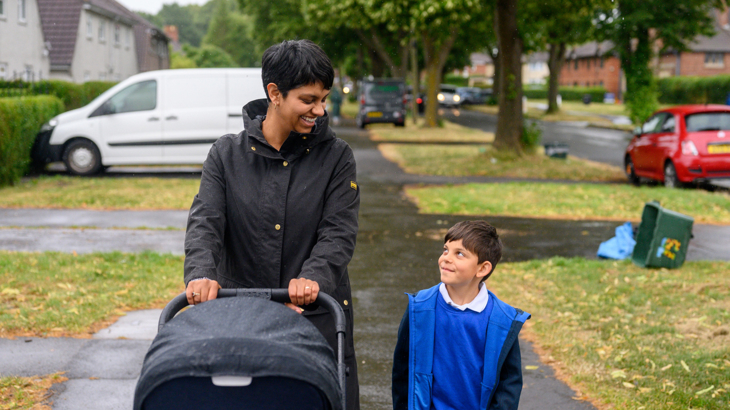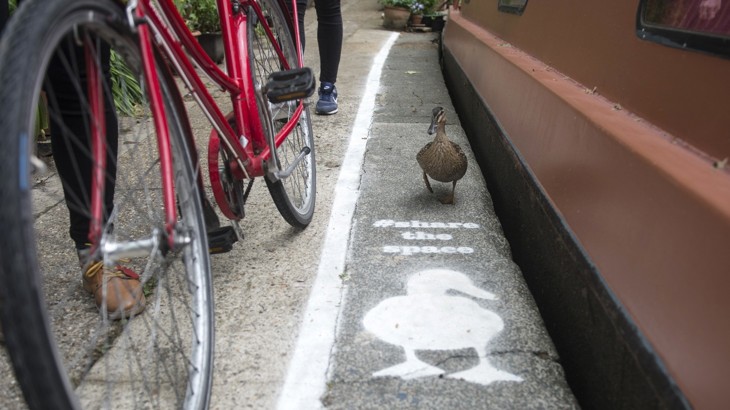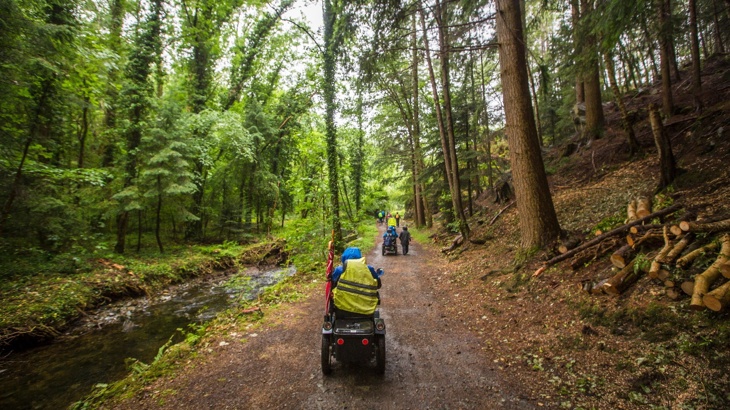What actually happens when we walk, wheel or cycle more? Changing the way we travel can play a surprisingly big role in helping to protect the environment. So here are five ways that walking and cycling more can help save our planet and benefit the communities we live in.

Big changes are inspired by us as individuals. Together, we can create a collective demand for a world we want to see. Credit: Jon Bewley
It's now widely agreed that unless we make some big systematic changes, climate change is going to get rapidly worse. And so will its effects on our everyday lives.
This requires transformation within many of society’s big systems, like energy, fashion, food and travel.
At Sustrans, we know what the UK could look like when sustainable and active travel is at its core.
We research and give evidence to the far-reaching benefits that walking and cycling can have for everyone. And the ways it can benefit the planet too.
Big changes are inspired by us as individuals by making small changes to our lives. And together, we can create a collective demand for a world we want to see.
When we start to walk, wheel and cycle more we’re not just boosting our own physical health and happiness but also creating a greener, safer environment for those around us.
It’s not just people we’re benefitting but the natural environment too.
Here are the five ways getting active can have a positive impact on the planet.
Here are five ways that walking and cycling can help protect the environment
1. Reduces air pollution
Air pollution is the term given to the small particles, chemicals and gases that are released into the air.
Motorised road transport contributes to air pollution through its use of fuels. Which includes carbon dioxide (CO2), nitrogen dioxide and particulate matter.
All of these have an impact on our health and on the health of the planet.
For example, CO2 traps heat into our atmosphere. The warmer our atmosphere gets, the harder it is for us to live in a healthy and happy way.
By choosing to walk and cycle a journey rather than using a car you are helping to reduce air pollution.
It's estimated that 5.2 million car trips could be saved over a year thanks to our work with schools and projects like the Big Pedal.
These car trips will equate to approximately 8.5 million miles of car journeys removed from our roads.
And this decrease in car travel would mean a potential saving of approximately 2,500 tonnes of carbon dioxide equivalents. A huge win for cleaning up our air.
2. Creates a need for more green spaces
If more people walk or cycle, we’ll need more traffic-free spaces.
And many of these will be green spaces. Areas with trees, plants and wildlife.
This is important for the environment because trees and other plants take some of the carbon dioxide out of the air.
They, therefore, reduce our carbon emission levels and increase clean air.
Better air quality and green, open spaces are not only good for the environment but they're also good for our physical health and for our mental health too.
Access to the outdoors and being able to move safely around local areas have also never been more important than throughout the Covid-19 pandemic.
An increase in demand means that local governments can work to re-design our cities and towns for the health and safety of the community.

Animals have to alter their behaviour and locations to avoid noise pollution. These changes have a knock-on effect on our whole environment. Credit: Canal and River Trust.
3. Boosts biodiversity
Biodiversity refers to the number and types of plants and animals that exist in a particular area. It describes all life on earth and how it interacts with each other.
High levels of biodiversity are crucial for many reasons. A healthy ecosystem is responsible for the quality and variety of our food, as well as the quality of our air and water.
Climate change is greatly affecting the amount of biodiversity we have on earth.
As the temperature gets warmer and the weather gets more unpredictable, fewer plant and animal species can survive.
Switching to walking or cycling for more of our shorter journeys helps to protect biodiversity.
It creates less noise, less air pollution, and results in fewer emissions that are warming the atmosphere.
We can help to protect our green spaces by showing its importance to communities, and to plant and wildlife. This will lower the risks of these spaces being used for new roads and motorised transport links.
4. Reduces noise pollution
Noise pollution is unwanted or disturbing sounds that affect the health and wellbeing of humans and animals.
Studies show that noise pollution affects the ability of local wildlife to survive.
Animals have to alter their behaviour and locations to avoid noise pollution. And these changes have a knock-on effect on our whole environment.
When certain birds leave a certain forest, that forest may start to decline. This is linked to biodiversity and shows the complex, natural systems our environment requires.
Walking or cycling helps to reduce the number of motor vehicles using the roads, lowering congestion and the noise that comes from engines.
Less noise from vehicles and idle traffic helps local wildlife to stay and thrive.

The increase in uptake helps build momentum and demand for better access to safe, traffic-free environments. Credit: Anthony Pease
5. Inspires behaviour change
Choosing more active ways to travel like walking and cycling has important benefits for us as individuals.
Staying active is good for our physical health. It also helps to boost our mood and can even save us money.
When you make a commitment to walk and cycle more, those around you will see the difference you're making.
They may even be inspired by the benefits they see you experiencing and give it a go themselves.
By inspiring others around you to walk and cycle more we start to build a ‘new normal’.
One simple action we can take to protect the environment is to walk, wheel or cycle our short journeys.
Our 2019 Bike Life survey found that only 28% of residents think cycling safety in their city is good.
But as more people ditch the car, we’ll help build momentum and demand for better access to safe, traffic-free environments.
When there’s more of us moving around in a sustainable way, this creates a greater demand for green spaces and pushes local governments to improve our towns and cities to make them healthier, safer and less car-oriented.
Find out why walking and cycling are great for your mental health.





